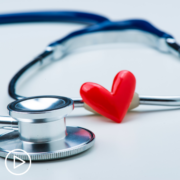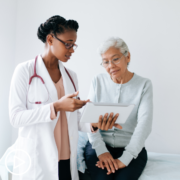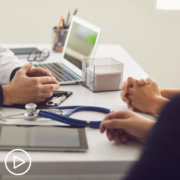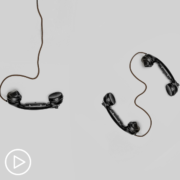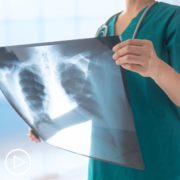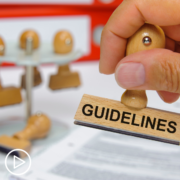HCP Roundtable: Shared Decision-Making in Myeloproliferative Neoplasm (MPN) Care from Patient Empowerment Network on Vimeo.
What does shared decision-making look like in myeloproliferative neoplasm care? How should fellow MPN specialists explain disease progression to patients and care partners? In this HCP-to-HCP roundtable discussion, experts Dr. Gabriela Hobbs and Natasha Johnson share best practices for helping your MPN patients play an active role in managing their health.
Dr. Gabriela Hobbs is a hematology-oncology physician specializing in the care of patients with myeloproliferative neoplasms (MPN), chronic myeloid leukemia, and leukemia. Dr. Hobbs serves as clinical director of the adult leukemia service at Massachusetts General Hospital and is an assistant professor at Harvard Medical School.
Natasha Johnson, is an Advanced Oncology Nurse Practitioner at Moffitt Cancer Center, where she cares for people living with MPNs with kindness, patience, and humanity. Natasha also speaks at conferences to educate other healthcare professionals about MPN care, research, and treatment.
Download Resource Guide
See More from Empowering MPN Providers to Empower Patients (EPEP)
Related Resources
Transcript:
Nicole Rochester, MD:
Welcome to this Empowering Providers to Empower Patients program. My name is Dr. Nicole Rochester, I’m a pediatrician and the CEO of Your GPS Doc. This program is for providers who desire to empower their patients and families. In this Patient Empowerment Network program, we connect MPN expert voices to discuss enhancing physician-patient communication and shared decision-making in MPN care. Some of the topics we’re going to cover today include how to help your MPN patients play an active role in managing their care, healthcare provider recommended strategies for managing disease burden to minimize disease impact on MPN patients’ lives, the importance of advanced practice clinicians on the health care team of MPN patients, clinical trials and the importance of nurses addressing this topic with their patients and families, as well as cultural humility in action.
I’m thrilled to be joined by MPN experts, Dr. Gabriela Hobbs, Director of the Adult Leukemia Services at Massachusetts General Hospital and Assistant Professor of Medicine at Harvard Medical School. Dr. Hobbs leads multiple investigator-initiated clinical trials in MPN as well as non-interventional trials, assessing outcomes for patients with MPN.
I am also thrilled to be joined by Natasha Johnson, an Oncology Nurse Practitioner at Moffitt Cancer Center, where she cares for patients living with MPN. Ms. Johnson also works to educate other healthcare professionals about MPN care, research and treatment. Thank you both for joining me for this important conversation.
Natasha Johnson:
So glad to be here. Thank you.
Gabriela Hobbs, MD:
Thank you so much.
Nicole Rochester, MD:
So I’d like to start by talking about the MPN care team and best practices for shared decision-making. We hear a lot about shared decision-making in healthcare. I would say for some, it’s more of a buzzword than an actual practice. I’m sure that you all agree that it’s incredibly important and really a core for the type of care that we should provide patients and their families, so I’d love to hear from each of you about what does that actually mean? What does shared decision-making look like in myeloproliferative neoplasm care. And we’ll start with you, Dr. Hobbs.
Gabriela Hobbs, MD:
Great question. I think shared decision-making can take many different forms in many of our clinical encounters, and I think one of the luxuries that we have in myeloproliferative neoplasms is that a lot of the decision-making that we need to make doesn’t have to happen immediately, and we also have the luxury of really getting to know our patients over time. And so having that longitudinal relationship, I think really helps in shared decision-making, because I know who that patient is, I know what’s important to them, we get to know their families, and they’ve also gotten to know our care team throughout our relationship. But in general, when we do need to make a decision about treatment, using that foundation, I think is really what’s most important for shared decision-making.
Gabriela Hobbs, MD:
Oftentimes, patients are the drivers of a lot of these decisions and they’ll bring up the questions, but, of course, every patient is a little bit different, and sometimes I need to be more on the side of bringing up the questions, etcetera. So I think knowing where your patient is emotionally, what’s important to them, what are their worries, is really important, so you can have a conversation where you’re not just speaking about the things that you as a provider think is important, but really also listening to where the patient is coming from, and so that you can make sure that you’re appeasing their anxieties and whatever decision you make is consistent with both what you think is medically important, but also with what’s really important for the patients. I think listening is really at the core there.
Nicole Rochester, MD:
Love that you highlighted listening. I think that’s something that we often don’t do enough of in healthcare, so thank you for that, Dr. Hobbs. What about you, Ms. Johnson? What are your thoughts about shared decision making in MPN care?
Natasha Johnson:
Yeah, I agree with everything Dr. Hobbs said. I really believe it’s just…it starts with conversations and taking the time, making sure that you have the patient, you have the caregiver, if they can’t be there in person, sometimes you’re calling them on the phone. If it’s through Zoom visit they’re joining, and the health care provider, and I think that we spend a ton of time educating them to make sure that they really understand this disease, the symptoms that go along with it, the treatments that go along with that, and once we have a good confidence that they understand everything, lead them into discussing what their goals of care are, and then we take all that information together, and we create a treatment plan specific to that patient, really aiming to improve their quality of life and overall survival.
Nicole Rochester, MD:
Awesome, so both of you spoke about the importance of listening and of really understanding the goals of the patients and their care partners, their family members, understanding their values, but we know that in reality, when you’re in that examination room and when you have all the distractions and all the competing priorities and the limited time, which is the thing I hear about most, I think, when I’m talking to colleagues, sometimes it can be difficult to put this into practice. So what can you share with fellow providers, maybe some tips or tricks or strategies that in face of all of those known barriers, how can they help patients take a more active role in managing their MPN? And we’ll start with you this time, Ms. Johnson.
Natasha Johnson:
All right, so one thing I would say is that here’s why I really think there’s a benefit to seeing an MPN expert that is at a national cancer center, academic center. I do think there is some more time allotted to those visits, especially the consults and first appointments for the patient, and we kind of start this with my doctor and other providers of assessing how much does the patient even know to begin with? So that can direct us where to start. And then how deep do they want to go. You know sometimes we have patients that they want to get down to the nitty-gritty and know all the scientific details, and other ones are like, Just lay it out for me easy. So really like assessing that from the beginning and then…so then start educating. Just like I said before, what does the disease look like, the symptoms, the treatment, alleviating symptoms, explaining that this is only cured by transplant. I think that’s really important to discuss right up front, and if they start treatment, usually treatment is indefinite. Of course, it’s changed depending on things, but educating them, so spending that time and then providing resources.
So we do this a lot by…I write a lot of things down for my patients when I see them, I think visuals are really helpful, provide literature, I tell them what websites to visit. A lot of times, they just will Google their doctor, which is great because they can find them and listen to their own lectures, and they really learn a lot. So just guiding them to those resources. I do think it’s important, too, to give them something like the total symptom score form. Just having that visual of, these are what is common, and then they can think about that between visits, but I think all of those things really help to educate them and get them involved.
Nicole Rochester, MD:
Awesome, thank you for that, Ms. Johnson. What about you, Dr. Hobbs? Do you have any additional strategies that really help to empower patients to manage their care?
Gabriela Hobbs, MD:
I think everything that Ms. Johnson said was spot on, and I agree with everything that she said. A few additional things that I would add to that is reminding a patient that they don’t need to remember every single thing we talk about at every single encounter, this is an ongoing conversation and decision-making will happen over time, especially when we’re trying to make more difficult decisions about when or if they have to go to transplant, for example. Sometimes I have a conversation with my patients for years before they actually get a transplant. Other things that I think are helpful strategies is reminding patients that they can be in touch.
Nowadays, we have so many different ways of keeping in touch with our patients, they know how to call our practice nurses in our clinic, how to get in touch with the nurse practitioner that I work with the most, how to get in touch with me through the patient portal. And so, knowing that when that visit finishes, which sometimes does feel short, even if…like Ms. Johnson said, we do have the luxury of time more in academic centers, they’re still…the patients will invariably get out of the room, get in their car and be like, “Oh, I forgot to ask that one question.” And so reminding them that they can get in touch, and then helping them to prepare for their next visits to make the most out of those visits, especially for some of those patients that maybe don’t always necessarily come back to see me.
There are some patients that live far away, and then they maybe see me infrequently, talking to them about the symptom assessment form, like Ms. Johnson said, pointing them to the right direction in terms of literature and reminding them that, especially for those patients that are very symptomatic, for example, keeping track of their symptoms over time, writing down notes about how they felt, what they think made something better, made something worse, how they’re responding to these medications, questions that they may have, and writing all of that down helps them be more empowered patients. They can advocate for themselves in a more organized way when they do go see either me or another clinician. So they come in fully prepared with the information and the questions that they want to get out of that visit.
Nicole Rochester, MD:
Perfect, thank you both. That’s really important. And so this leads nicely into our next topic, both of you have mentioned the importance of tracking symptoms, and so we want to shift and talk about strategies for managing disease burden, and I’d love to hear from each of you about what are your recommendations as you speak to MPN patients and their care partners about symptoms? How should other providers bring up those conversations and what are the best ways to really elucidate the symptoms that patients with MPN are having? So I’ll start with you, Dr. Hobbs.
Gabriela Hobbs, MD:
So this may sound obvious, but the first way of figuring out what symptoms a patient has is by asking, and it’s so interesting, right? There have been studies comparing what symptoms are most important to patients and what symptoms clinicians think the patients have. And guess what, the clinicians don’t actually know which symptoms the patient has, or which symptoms are most important to the patient, and…so anyway, it sounds obvious, but it sometimes isn’t, and I think clinicians are busy and sometimes feel like having a tool to ask those questions is maybe too burdensome. I personally find that the MPN symptom assessment form is a quick form, it’s easy to complete, it can be given to a patient, there’s a piece of paper while they’re waiting for you.
And that also directs the conversation because it really just gives numbers, makes it objective, and then can really start that conversation. And so remembering that we do have this tool, it actually can help cut down time to the visit and make it more focused, and it’s helpful to…empowers the patient and make sure that you really are asking about all of those symptoms, and just making sure that you don’t just assume that a patient has or doesn’t have a symptom, but really saying, “Are there any other symptoms that you’ve noticed?” I’m trying to be really thorough because, honestly, MPN symptoms can manifest in so many different ways for our patients in addition to those 10 symptoms that are asked in the MPN symptom assessment form, and so trying to be thorough about those symptoms, I think, really important.
Nicole Rochester, MD:
And thank you for that and for highlighting sometimes this disconnect between the patients and the clinicians, and also the fact that what’s important to us may not be as important to the patient, and what’s important to the patient may get overlooked by us, and so again, it’s always going back to centering the patient and their experiences. Do you have anything to add, Ms. Johnson, with regard to talking to patients about their symptoms?
Natasha Johnson:
Yes, I had to just laugh in on my head with what Dr. Hobbs said, because it’s so true. With MPNs, numbers are a big deal in this world, and we can see a patient and just look at their numbers and think, “They look good,” and then you see them and they’re like, “I feel horrible.” And it just doesn’t relate. And so I agree with what she said, really going over what are the common symptoms and then thinking about, if they’re on treatment, is this like a medication side effect or is this a disease-related symptom, and then thinking just about comorbidity. So often our patients can have CHF or pulmonary hypertension that’s contributing to their symptoms, and so discussing that and trying to get those things managed.
Nicole Rochester, MD:
Awesome, Dr. Hobbs, did you have something you wanted to add?
Gabriela Hobbs, MD:
Yeah. You know what I was thinking, we also have obviously very different personalities for our patients, of course, in addition for our clinicians, and there are sometimes patients that are very vocal, will come in and share every single symptom, and then we have some stoic patients that never complain, but for those patients, it’s very helpful to turn around and look at the spouse. And so you’ll ask the patient, “Are you tired?” “No, I’m fine.” “Are you whatever?” “No, everything’s okay,” and then the spouse is like, “But remember, you really haven’t been having your dinner, and remember how you were complaining about how your stomach was hurting every time you ate. And you say you’re not itchy, but every night when we’re watching TV, I turn around and I see that you’re scratching.” And so I think that’s also a really important tool to make sure that you make use of the family members, because they really know what’s going on if the patient is not willing to share as much or doesn’t like to complain. [chuckle]
Nicole Rochester, MD:
Oh, Dr. Hobbs, you are reminding me of my former caregiving experience. There were so many occasions where my dad, who did not have MPN by the way, but my dad would…he was that stoic person who would downplay everything, even though the entire car ride to the doctor’s office, he had been complaining, [chuckle] but in front of the doctor he was always fine.
Gabriela Hobbs, MD:
Everything is fine.
Nicole Rochester, MD:
Yeah, I was the care partner that was like, “But what about what you said 5 minutes ago?” So I appreciate you sharing that. We cannot overemphasize the importance of engaging with those incredible care partners. So you all both mentioned there are a lot of symptoms and those symptoms can really have an impact on patients and on their families, their care partners, what specific strategies can other providers use to explain how to minimize the disease impact of MPN? And I’ll start with you, Ms. Johnson.
Natasha Johnson:
Okay, so the number one symptom I hear is fatigue, and it has nothing really to do with hemoglobin, whether it’s normal or not. It’s so many factors that go into the disease, that cause it, and then also considering comorbidity, so I really try to encourage patients to be as active as possible. And we’ve seen with some of our solid tumors and studies that have been done when fatigue’s an issue, activity or physical exercise really seems to be the best way to combat that.
And I really try to encourage them. “Once you stop doing something and you sit down, it’s going to be hard to get back up and do it again. So pace yourself and do what you can.” But that is a big encouragement that I give. And then a second one I would say is diet. There’s been some new interest in looking at the Mediterranean diet, and that it has a possible benefit in reducing symptom burden in patients, so I think that’s something we can continue to look into, but it certainly can’t hurt a patient, especially when you look at cardiovascular risk factor, so just encouraging healthy diet. But I’m also a great advocate for, if they can eat, I want them to enjoy life and eat, too. So I go back and forth a little bit on that depending on the patient. And then just lastly, I really do encourage them to live, you know, live each day, continue living, and I have some patients that play pickleball several times a week and can be really active and enjoy that, and some, it’s just maybe having their neighbors over to play cards once a week, and that’s okay. Or their family, or their church community. Just an encouragement that if they’re living and trying to have healthy habits, I really think it can improve symptom burden.
Nicole Rochester, MD:
Dr. Hobbs, are there any non-pharmacologic strategies that you endorse? And I’m asking you specifically because I think a lot of times, patients and care partners think that physicians aren’t well-versed in non-pharmacologic therapies or that we don’t endorse non-pharmacologic therapy. So I’m curious to know if there are any that you tend to recommend to your patients with MPNs.
Gabriela Hobbs, MD:
I love this question, and I’m glad to have an opportunity to talk about it, and I loved everything that Ms. Johnson said. For many years, I’ve felt in my practice like I’m a primary care doctor, and I’m talking to patients about diet and exercise, [chuckle] especially for the patients that have essential thrombocythemia and polycythemia vera or low-risk myelofibrosis, those diseases really are diseases that I think about as another cardiovascular risk factor. And when we’re talking to patients that have cardiovascular risk factors, like obesity, like hypertension, like hyperlipidemia, diabetes, etcetera, what do we talk to them about? We talk about lifestyle modification. And I think that that fits in beautifully in the care of a patient with an MPN because there’s nothing like getting a diagnosis to take away control from your life. And so giving patients control back by saying, “Actually, you do have control over this disease by changing your lifestyle, by living an active healthy lifestyle and having a well-balanced diet,” I think can actually be very helpful.
One of the things that we don’t talk a lot about in MPNs, ’cause we’re focused on cell signaling and new fancy medications, is just the basics, lifestyle modification. And so I’m a huge fan of that holistic approach. I loved what Ms. Johnson said about, “Don’t let yourself be defined by this disease.” Let’s really find a way of improving your quality of life and maximizing how you live your days. And so I think talking to them about lifestyle modification is something that is really near and dear to my heart. We have a clinical trial now helping patients to really change their lifestyle, get more active and eat more healthily, and I think that those things are actually really, really important. Many of my patients, the first thing they do when they get diagnosed is they want to go and find that magical supplement that’s going to change their natural history of their disease. And although I can’t really say if any of those supplements are going to be helpful or not, I can for sure say that there is no harm, and there’s probably benefit to staying active and also to having a more plant-based, less processed food diet. And I think that that really goes a long way in terms of helping patients to improve their symptoms, feel less tired and feel less anxious, also feel like they have more control over what’s going on with them.
Nicole Rochester, MD:
Wonderful. That’s great to hear. So I wanted to shift again and start to talk about specifically disease progression. And we know that that is, unfortunately, something that is an important element of MPNs. And so as we talk to fellow MPN specialists, what are you all’s recommendations for how they can best explain disease progression to patients? Are there any specific languaging or specific tactics that you all use, and even things that maybe you shouldn’t say as you are sharing information about disease progression? Either one of you, feel free to go first.
Gabriela Hobbs, MD:
So disease progression, I think is a really challenging topic, because on the one hand, I think it’s really important to educate patients. It’s really important for patients to know that that is a possibility, that it is something that can happen. It’s really challenging to have a patient that has lived with this disease for a long time, hardly even knows the name of that disease. Maybe they were seen elsewhere, etcetera, and then all of a sudden, something’s going wrong and they just weren’t prepared for that. But I feel like that really does need to be balanced by the fact that, thankfully, progression happens infrequently. And so you also…going back to what we were saying before, you want to help a patient to be able to live well with these diseases and not be defined by those diseases. And so one of the things that I try to do with patients is, especially during that initial visit, I spend some time explaining to them what the disease is, that it can progress to myelofibrosis, that it can progress to leukemia. But then I also try to reassure them as much as possible that this is an infrequent event, that the reason why we follow patients in-clinic is so that we can start to notice if there’s disease progression, that it usually happens gradually.
And then I try to say, “You have this information. We can’t necessarily change that at this moment, there are maybe some tools that we can use in the future, but try to put that information in a box in your brain, put the key, put it away, try not to think about that every day when you’re outside of here. Definitely okay to open that back up when you’re with me in the room. If you want to get those anxieties out, that’s fine, but let’s really try to make sure that that’s in the back and not at the forefront of our thoughts.” And kind of going back to one of the things we were discussing before about what the patient thinks is most important, what the clinician thinks is most important. If you ask patients what are they most concerned about with their MPN, oftentimes that response is, “Is my disease going to progress?” And so I think acknowledging that and talking about that is important, but then also reminding patients that over time, they need to, hopefully with your help, or maybe they need additional assistance with therapists or social workers, etcetera, let’s find a way to put that away so that it’s not really at the forefront of our thoughts every single day, because that also ends up being not productive.
Nicole Rochester, MD:
I love that approach, of providing the education, but also that balance that you talked about, Dr. Hobbs. I love the idea of putting it away, putting it in a box [chuckle] and locking it, and then opening it back up when you’re in the safety with your healthcare provider. That’s beautiful.
Do you have anything to add to that, Ms. Johnson?
Natasha Johnson:
I completely agree. Your example there of putting it in the box, I’m going to use that in clinic. [laughter] I think it’s a great visual for patients. Because like you said, they’re very scared, and it can control them and take over, and we don’t want the disease to take over their life. Still live. Enjoy.
Nicole Rochester, MD:
Absolutely. So as we start to wrap up, we definitely want to address the role of advanced practice clinicians. We’re honored to have Ms. Johnson here with us, a nurse practitioner. And you mentioned earlier, Dr. Hobbs, that you work very closely with the nurse practitioner, so I’d love for you to share, Dr. Hobbs, the importance, in your professional opinion, of the role of advanced practice clinicians in MPN care. And how can fellow providers best leverage and utilize advanced practice clinicians?
Gabriela Hobbs, MD:
I love that Ms. Johnson is here with us. And I am thinking about Judy, the nurse practitioner that I work with the most. And honestly, without her and without the NPs that work in our clinic, I’m pretty sure that our clinic would fall apart, [chuckle] so I don’t have enough important…I really don’t have enough good things to say about the NPs or the advanced practice providers. They really play a huge role in the care of our patients and in so many different ways. I think sometimes a patient will feel more comfortable sharing some things either with the practice nurses or with the nurse practitioners. Sometimes having just a different perspective from another clinician is so helpful for the patient. Sometimes even if the two of us are communicating similar information, just to hear it slightly differently in another perspective can be really so helpful. Another thing that I think is also really essential about having that team approach is that when I’m away, if I’m on the inpatient service or Judy is away, [chuckle] the patients always know who they’re going to see when they come to the clinic. There’s that great continuity of care. And so I think the fact that there are two of us taking care of a patient as opposed to just me ends up really being very, very helpful for the patients, because they know that when they come to see us, they’re going to see somebody that really knows them longitudinally. And so two is better than one, honestly.
Nicole Rochester, MD:
Two, absolutely better than one. And Ms. Johnson, how would you describe your role? Or maybe is there one example of how you partner with physicians and other members of the team, or maybe something that stands out for you that you’d like to share with the audience?
Natasha Johnson:
Yes. So I work with two main physicians, and one of them is a MPN expert. And so he sees them in their consult initial visit. And then oftentimes, they’re following up with me for those more frequent visits. Our physicians are performing research, they’re teaching, so they’re not in clinic as many days a week as, like I am. And so I do see him more often and really get to know them. But I communicate with my physician almost on a daily basis. And because our relationship has grown, I think that he’s come to trust me to know that I can pick up on…when I’m concerned about disease progression, I know that I can go to him and talk to him, and he’s there. And then he also helps me to make…or he also trusts me to make more minor treatment decisions. But when things are a big deal, I call on him, and he’s there. Oftentimes, if the patient come in and we did not expect this and it’s obvious they’ve progressed, he’ll come into the room with me, and I really believe that makes the patient so much more comfortable. They enjoy seeing me. And we have a good relationship, but it’s different when it’s coming from your physician. And so yeah, we work really close, we communicate regularly. I try to ensure the patients of that. But I do develop very close relationships with patients, because I’m seeing them more routinely and more often.
Nicole Rochester, MD:
That makes perfect sense. It takes a team, right? I mean, we talk about healthcare teams, and that’s really what you all are describing, is teamwork in action. Lastly, I want to wrap up by talking about cultural humility. You all have spoken so eloquently about the importance of developing true, genuine relationships with patients and their care partners and valuing what’s important to them and bringing them into the shared decision-making. And we also know that our patients come with their own unique racial and ethnic and cultural backgrounds, and that sometimes, unfortunately in healthcare, we don’t take those things into consideration. So when we talk about cultural humility, we’re really talking about acknowledging a patient’s full, authentic self, their full, lived experiences, and also acknowledging our own biases that we bring to the table, listening to our patients and having that interest and that curiosity. So I’d love for you to either share an example of when you or a fellow provider were able to show cultural humility in action, or maybe a specific tip for the providers that are watching this program about how to truly incorporate cultural humility into your practice. We’ll start with you, Dr. Hobbs.
Gabriela Hobbs, MD:
I love that question. And I think this is something that is a lifelong process for all of us, and I think it starts with awareness, really just recognizing that you bring your own background and bias into every encounter. And that’s okay. So I think sometimes we want to feel like we’re color blind and culture blind and that we see everything the same. But we have our own biases. And one example for me where that’s always true is, I’m a physician, but I’m also an investigator, and so, obviously, I have a bias towards research. For me, it’s obvious, yeah, of course, I’m wanting to participate in a clinical trial.
And I think you have to be aware of the fact that clinical trials come with all sorts of different opinions from patients, patients don’t like to be guinea pigs, there is mistrust, there’s all sorts of history in [chuckle] this country, especially about clinical trials. And I think coming into those encounters, like I said at the beginning of our conversation, taking into account that you really do know your patient. But sometimes, you don’t know the patient as well. You’re getting to know them, and you need to make a decision. Just listening, being humble, being aware, trying to understand where the patient is coming from, I think sometimes, especially when you’re trying to make a decision quickly and you find that there’s some friction, I think taking some time to say, “Alright, where is that coming from?” And perhaps I’m coming across too strong with this recommendation to do this clinical trial and there’s maybe something that I need to explore, and so just keeping an open mind and trying to just ask questions, “Where are you coming from? What’s important to you? Why are you hesitating? Or is there something that I can explain in a different way?” And really trying to get the whole picture of who that patient is and where they’re coming from. I think that’s probably a really important one.
Another example and I’ll let Ms. Johnson talk.
It comes often in my practice, I speak Spanish and I realize the moment that I switch languages, for example, with a patient, the whole conversation can change. And so in some instances, I have the ability to truly get into that cultural mindset very well because it’s a culture that I’m very familiar, and so you can break those barriers more easily. But then there’s some other situations, or maybe a culture that I’m not as familiar with and I don’t speak the language, or I don’t speak to culture, and you need to keep that in mind and realize, “Okay, here, I don’t know exactly all the same custom,” so I need to take a step back, be humble and just ask a lot of questions, and just acknowledge that, and that’s okay.
Nicole Rochester, MD:
Absolutely. Thank you so much for sharing that. What about you, Ms. Johnson? Any examples or anything you want to reflect on regarding cultural humility.
Natasha Johnson:
Yes. When I think about this, I know that I have to go in prepared and be aware, so like educating myself on how does MPN affect this specific population, and with this culture, what are their values that they hold? And so when I’m going in to see the patient, just like Dr. Hobbs said, listening, being respectful, watching my body language, discussing all treatment options. And just two quick examples I can think about is, one, I’ve had a patient due to religious beliefs can’t take transfusions. And so a lot of times anemia is a big deal in our situation, and so really being creative with the treatments to not really worsen that and be okay with it. And you’d really be surprised how a patient can go around with a hemoglobin of like 5 and live normally when their body gets used to it. But I remember just that patient very well and having to respect that and understand it. And then the second is, I’ve had patients progress and they need to go to transplant or we need to do a bone marrow biopsy to really see where the disease is at right now. And in my mind, I think, “You’re fit. You feel good, like pushing these things,” and I have to step back and look at the patient and listen to the patient. And they’re telling me, “Right now for this, this or this reason, I don’t want to do this. And my priorities are over here.” And just really respecting the patient and still taking 100 percent great care of them through all that.
Nicole Rochester, MD:
Well, this has been a phenomenal conversation. I really appreciate you all’s insight, your expertise. It’s time to wrap up. And you all have said a lot. You’ve talked about the importance of addressing symptoms, you’ve talked about getting to know patients and their care partners, you talked about the idea of centering our patients and their care partners and making sure that we understand their values, we’ve talked about disease progression, we’ve talked about holistic care and cultural humility. Do you have any closing thoughts, any one last thing that you want to leave with the audience as we wrap up this amazing program? We’ll start with you, Ms. Johnson. Any closing thoughts?
Natasha Johnson:
I think of three things, assessing, educating and providing. So assessing your patient by listening, really getting to know them, seeing what they understand, educate them. Not to put fear in them, but to educate them so that they are well-empowered on their disease and how we’re going to move forward. And then providing them with resources regarding treatment with ways to alleviate symptoms so they can further their knowledge as well. So that way overall, we are aiming our goal to improve their quality of life and their overall survival.
Nicole Rochester, MD:
Awesome. Thank you for that. And what about you, Dr. Hobbs? Any closing thoughts?
Gabriela Hobbs, MD:
Hard to say anything better than what Ms. Johnson just said, [laughter] But the only thing I’ll add, which I think is really in the same message, is to remember that there’s a ton of hope, and I think our patients are nervous and they’re worried about this disease, but this field is changing rapidly there’s so many clinical trials in this space and new medications that are likely to be approved. That I think it’s important to remind patients that even though right at this moment, you know, the only curative treatment is a bone marrow transplant for those patients with myelofibrosis, I really do feel very optimistic that there’s going to be a lot of different treatments in the next couple of years that are going to be available for them. And so education is critical, and leaving those patients with hope at the end of each encounter is something that’s also really important.
Nicole Rochester, MD:
Well, I love that we’re ending the program with a message of hope. Thank you so much, Dr. Hobbs, Ms. Johnson, thank you for your time and thank you to all of you for tuning into this Empowering Providers to Empower Patients program. Have an amazing day.
Share Your Feedback:
Create your own user feedback survey


